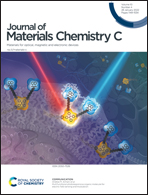Inverse photoconductivity effect in triple cation organic–inorganic hybrid perovskite memristors with various iodine concentrations, electrodes, and modified layers†
Abstract
With the advantages of light absorption ability, photo-stability and moisture resistance, triple cation perovskites (TCPs) have great application prospects in optoelectronic devices. Here, we reveal a novel inverse photoconductivity (IPC) effect in TCP-based memristors with different conditions like iodine concentration, electrode type, and modified layer. First, the doping of iodine facilitates the negative conductivity effect, with the current switching mechanism changing between analog and digital type. When an active top electrode is applied, the hysteresis loop is largely reduced, and new photocarriers shield the trap effect, which leads to an unexpected decline of current values. Finally, the deposition of modified layers can largely reduce the current values. For the ZnO-modified layer, the conductivity enhancement induced by the electric pulse is reduced, and the retention characteristics of memristors become worse and decay faster under illumination. Our results would open a novel inverse photoconductivity horizon in perovskite photo-memristor applications.



 Please wait while we load your content...
Please wait while we load your content...